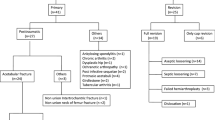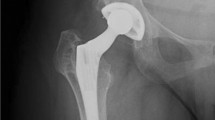Abstract
Introduction
Hip resurfacing (HR) is intended to preserve the femoral bone stock during primary arthroplasty. On the other hand, little has been reported regarding the intraoperative need of bone reconstruction for extended acetabular defects during hip resurfacing revision. Thus, the aim of the presented study was to identify whether there is an increased need for acetabular bone reconstruction in HR revision surgery.
Materials and methods
We analyzed the data of 38 patients who underwent 39 conversions from a HR to a total hip arthroplasty (THA). Acetabular bone defects and the respective revision technique were compared against a temporary cohort of patients undergoing revision surgery of a conventional THA.
Results
In 29 HR patients revision required either autogenous or allogenous impaction bone grafting to adequately manage acetabular host bone degradation. In 10 cases additional implantation of a reinforcement device was necessary. Compared to the THA cohort revision of failed HR is associated with a significantly increased risk of higher grade bone defects (Paprosky classification) and extended acetabular reconstruction (p < 0.05).
Conclusions
This study provides evidence that revision of failed HR devices is associated with an increased risk for extensive acetabular defects. Furthermore, the preoperative radiographic assessment of HR devices often underestimates the intraoperative acetabular defect. Surgeons should be aware of this fact not to technically underestimate HR revision procedures.

Similar content being viewed by others
References
Bozic KJ, Kurtz S, Lau E, Ong K, Chiu V, Vail TP, Rubash HE, Berry DJ (2009) The epidemiology of bearing surface usage in total hip arthroplasty in the United States. J Bone Joint Surg Am 91(7):1614–1620. doi:10.2106/JBJS.H.01220
Chan FW, Bobyn JD, Medley JB, Krygier JJ, Tanzer M (1999) The Otto Aufranc Award. Wear and lubrication of metal-on-metal hip implants. Clin Orthop Relat Res 369:10–24
Firkins PJ, Tipper JL, Saadatzadeh MR, Ingham E, Stone MH, Farrar R, Fisher J (2001) Quantitative analysis of wear and wear debris from metal-on-metal hip prostheses tested in a physiological hip joint simulator. Biomed Mater Eng 11(2):143–157
Krantz N, Miletic B, Migaud H, Girard J (2012) Hip resurfacing in patients under thirty years old: an attractive option for young and active patients. Int Orthop 36(9):1789–1794. doi:10.1007/s00264-012-1555-0
Vendittoli PA, Lavigne M, Girard J, Roy AG (2006) A randomised study comparing resection of acetabular bone at resurfacing and total hip replacement. J Bone Joint Surg Br 88(8):997–1002
Silva M, Heisel C, Schmalzried TP (2005) Metal-on-metal total hip replacement. Clin Orthop Relat Res 430:53–61
Quesada MJ, Marker DR, Mont MA (2008) Metal-on-metal hip resurfacing: advantages and disadvantages. J Arthroplasty 23:69–73. doi:10.1016/j.arth.2008.06.015
Mont MA, Ragland PS, Etienne G, Seyler TM, Schmalzried TP (2006) Hip resurfacing arthroplasty. J Am Acad Orthop Surg 14(8):454–463
Triclot P (2010) Metal-on-metal: history, state of the art (2010). Int Orthop 35(2):201–206. doi:10.1007/s00264-010-1180-8
Ball ST, Le Duff MJ, Amstutz HC (2007) Early results of conversion of a failed femoral component in hip resurfacing arthroplasty. J Bone Joint Surg Am 89(4):735–741
Garrett SJ, Bolland BJ, Yates PJ, Gardner EM, Latham JM (2011) Femoral revision in hip resurfacing compared with large-bearing metal-on-metal hip arthroplasty. JArthroplasty. 26(8):1214–1218. doi:10.1016/j.arth.2010.10.010
Smith AJ, Dieppe P, Howard PW, Blom AW (2012) National Joint Registry for England and Wales. Failure rates of metal-on-metal hip resurfacings: analysis of data from the National Joint Registry for England and Wales. Lancet 380(9855):1759–1766. doi:10.1016/S0140-6736(12)60989-1
Huang DC, Tatman P, Mehle S, Gioe TJ (2013) Cumulative revision rate is higher in metal-on-metal THA than metal-on-polyethylene THA: analysis of survival in a community registry. Clin Orthop Relat Res 471(6):1920–1925. doi:10.1007/s11999-013-2821-1
Singh G, Meyer H, Ruetschi M, Chamaon K, Feuerstein B, Lohmann CH (2013) Large-diameter metal-on-metal total hip arthroplasties: a page in orthopedic history? J Biomed Mater Res A. 101(11):3320–3326. doi:10.1002/jbm.a.34619
Haughom BD, Erickson BJ, Hellman MD, Jacobs JJ (2015) Do complication rates differ by gender after metal-on-metal hip resurfacing arthroplasty? A systematic review. Clin Orthop Relat Res [Epub ahead of print]
Pandit H, Glyn-Jones S, McLardy-Smith P, Gundle R, Whitwell D, Gibbons CL, Ostlere S, Athanasou N, Gill HS, Murray DW (2008) Pseudotumours associated with metal-on-metal hip resurfacings. J Bone Joint Surg Br. doi:10.1302/0301-620X.90B7.20213
Hannemann F, Hartmann A, Schmitt J, Lützner J, Seidler A, Campbell P, Delaunay CP, Drexler H, Ettema HB, García-Cimbrelo E, Huberti H, Knahr K, Kunze J, Langton DJ, Lauer W, Learmonth I, Lohmann CH, Morlock M, Wimmer MA, Zagra L, Günther KP (2013) European multidisciplinary consensus statement on the use and monitoring of metal-on-metal bearings for total hip replacement and hip resurfacing. Orthop Traumatol Surg Res. 99(3):263–271. doi:10.1016/j.otsr.2013.01.005
Hartmann A, Hannemann F, Lützner J, Seidler A, Drexler H, Günther KP, Schmitt J (2013) Metal ion concentrations in body fluids after implantation of hip replacements with metal-on-metal bearing—systematic review of clinical and epidemiological studies. PLoS One 8(8):e70359. doi:10.1371/journal.pone.0070359
Parvizi J, Gehrke T (2014) International Consensus Group on periprosthetic joint infection. Definition of periprosthetic joint infection. J Arthroplasty 29(7):1331. doi:10.1016/j.arth.2014.03.009
Beaulé PE, Dorey FJ, Le Duff MJ, Gruen T, Amstutz HC (2004) Risk factors affecting outcome of metal-on-metal surface arthroplasty of the hip. Clin Orthop Relat Res 418:87–93
Rigby M, Kenny PJ, Sharp R, Whitehouse SL, Gie GA, Timperley JA (2011) Acetabular impaction grafting in total hip replacement. Hip Int. 21(4):399–408. doi:10.5301/HIP.2011.8587
Loughead JM, Starks I, Chesney D, Matthews JN, McCaskie AW, Holland JP (2006) Removal of acetabular bone in resurfacing arthroplasty of the hip: a comparison with hybrid total hip arthroplasty. J Bone Joint Surg Br 88(1):31–34
Grammatopoulos G, Pandit H, Kamali A, Maggiani F, Glyn-Jones S, Gill HS, Murray DW, Athanasou N (2013) The correlation of wear with histological features after failed hip resurfacing arthroplasty. J Bone Joint Surg Am 95(12):e81. doi:10.2106/JBJS.L.00775
Holton C, Bobak P, Wilcox R, Jin Z (2013) Impaction grafted bone chip size effect on initial stability in an acetabular model: mechanical evaluation. J Orthop 10(4):177–81. doi:10.1016/j.jor.2013.09.004
Schmidutz F, Fottner A, Wanke-Jellinek L, Steinbrück A, Jansson V, Mazzochian F (2012) Hip resurfacing requires larger acetabular cups than conventional hip replacement: a comparative analysis of 100 hips, based on radiographic templating. Acta Orthop Belg 78(4):484–491
Tanzer M, Tanzer D, Smith K (2012) Surface replacement of the hip can result in decreased acetabular bone stock. Clin Orthop Relat Res 470(2):541–546. doi:10.1007/s11999-011-2020-x
Jaiswal A, Gilbert RE, Sunil Kumar KH, Carrothers AD, Kuiper JH, Richardson JB (2011) Function and survival after revision of hip resurfacing. Hip Int. 21(5):610–615. doi:10.5301/HIP.2011.8679
Gilbert RE, Cheung G, Carrothers AD, Meyer C, Richardson JB (2010) Functional results of isolated femoral revision of hip resurfacing arthroplasty. J Bone Joint Surg Am 92(7):1600–1604. doi:10.2106/JBJS.I.00698
Sandgren B, Crafoord J, Garellick G, Carlsson L, Weidenhielm L, Olivecrona H (2013) Computed tomography vs. digital radiography assessment for detection of osteolysis in asymptomatic patients with uncemented cups: a proposal for a new classification system based on computer tomography. J Arthroplasty 28(9):1608–1613. doi:10.1016/j.arth.2013.01.029
Nam D, Barrack RL, Potter HG (2014) What are the advantages and disadvantages of imaging modalities to diagnose wear-related corrosion problems? Clin Orthop Relat Res 472(12):3665–3673. doi:10.1007/s11999-014-3579-9
Author information
Authors and Affiliations
Corresponding author
Ethics declarations
Conflict of interest
No benefits in any form have been received or will be received from a commercial party related directly or indirectly to the subject of this article.
Additional information
O. Jakobs and S. Schmidl contributed equally and thus are shared first authors.
Rights and permissions
About this article
Cite this article
Jakobs, O., Schmidl, S., Schoof, B. et al. Increased risk for extended acetabular reconstruction in failed hip resurfacing as compared to failed total hip arthroplasty. Arch Orthop Trauma Surg 136, 413–424 (2016). https://doi.org/10.1007/s00402-015-2364-x
Received:
Published:
Issue Date:
DOI: https://doi.org/10.1007/s00402-015-2364-x




